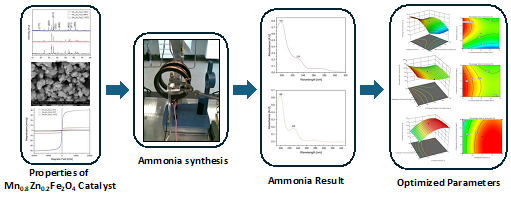Application of response surface methodology (RSM) and central composite design (CCD) to optimize of green ammonia production using magnetic induction method (MIM) and nanocatalysts
Main Article Content
Abstract
Ammonia synthesis in conventional industrial plants typically employs fused iron-based catalysts under harsh conditions—temperatures of 400–700°C and pressures exceeding 300 atm—resulting in significant energy consumption. This study investigates the potential of using a Mn0.8Zn0.2Fe2O4 catalyst, synthesized under varying sintering temperatures and magnetic field inductions, to enable ammonia synthesis under milder conditions. Additionally, process optimization was carried out using Response Surface Methodology (RSM) and Central Composite Design (CCD). Catalyst characterization results indicate that the crystallite size of Mn0.8Zn0.2Fe2O4 increases with higher sintering temperatures. The catalyst exhibits a near-spherical morphology with notable agglomeration. Magnetic property analysis shows that samples sintered at 700°C and 900°C display ferrimagnetic behavior, while the sample sintered at 1100°C exhibits ferromagnetic characteristics. Temperature-Programmed Reduction (TPR) revealed a maximum reduction peak at 788°C for the catalyst sintered at 1100°C, indicating enhanced reducibility. Ammonia formation was successfully achieved using a Helmholtz coil-assisted synthesis method, where the produced ammonia was captured in acidic and basic media in the form of NH₄OH and (NH₄)₂SO₄, confirming the catalytic activity of Mn0.8Zn0.2Fe2O4. The RSM model demonstrated high accuracy with an R² value of 99.73%, and residual analysis confirmed normal distribution, validating model assumptions. The optimal synthesis parameters determined were a sintering temperature of 700°C, magnetic induction of 0.14 T, and a reaction temperature of 28°C. The minimal deviation between predicted and experimental responses confirms the reliability and predictive accuracy of the quadratic regression model.
Downloads
Article Details

This work is licensed under a Creative Commons Attribution-NonCommercial 4.0 International License.

